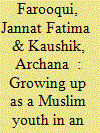|
|
|
Sort Order |
|
|
|
Items / Page
|
|
|
|
|
|
|
| Srl | Item |
| 1 |
ID:
184417


|
|
|
|
|
| Summary/Abstract |
This paper focuses on Muslim Civil Society structures and, more specifically, on the gap between the organizations from the first (migrant) generation and the new grammars of action of new generations of Spanish Muslims. The originality of this article lies in its power to address three fundamental questions: (1) Are the umbrella organizations silencing the demands of Muslim youth?; (2) How do Muslim youth resist such representative hegemony? and; (3) What specific strategies are Muslim women currently developing to gain representation and involvement in mainstream Spanish society? We find evidence for new grammars of action defying traditional authorities and reject decontextualized, asynchronous Islam. Young women are engaging in broader and inclusive activism, inspired by religion affiliation in order to reinforce their external solidarity and engagement in mainstream political structures. By contrast, young men are calling for a new Muslim leadership to reinforce primary solidarity and concentrate more on earning religious rights. For women, religion is a vector to participation and for men, it is a form of participation.
|
|
|
|
|
|
|
|
|
|
|
|
|
|
|
|
| 2 |
ID:
184415


|
|
|
|
|
| Summary/Abstract |
On Palawan Island, where approximately 80,000 Muslims of diverse ethnolinguistic and geographical origins reside together with a larger and similarly diverse Christian population, conversions from Christianity to Islam have become common. This paper explores how converts comport themselves individually and collectively with their interpretations of Islam and expressions of religiosity, and how the fragmented larger community of ‘born’ Muslims has in turn responded to the growing presence of converts who hope to ‘de-ethnicize’ Islam and build a single unified community whose sole criteria for membership is religious faith. Whereas born Muslims emphasize religion, whereby social and cultural authority supports literal understandings and correct bodily practices, Muslim converts are more concerned with religiosity—i.e., an emphasis on the way individual believers build and experience their relationships with God. Yet the convert community has itself taken on ethnic group-like characteristics, both by the actions of its members and by the workings of wider Philippine society, thereby insulating the ‘ethnic’ Islam of born Muslims from the very changes that converts desire. More broadly, the processes of deterritorialization and individualization sometimes attributed to global Islam are not entirely one-directional, as countervailing processes of re-territorialization and re-ethnicization are also underway.
|
|
|
|
|
|
|
|
|
|
|
|
|
|
|
|
| 3 |
ID:
184419


|
|
|
|
|
| Summary/Abstract |
Most analyses of nonviolent movements downplay the role that national identity may play in their success or failure. Our study aims to bridge the gap between those who focus on structure and those who focus on agency by comparing national identity in Iran’s Islamic revolution with the Green Wave. We argue that the Shah’s attempts to create a secularized Persian-based national identity ran afoul of deep-seated cultural connections to Islam: which were successfully harnessed by Ayatollah Khomeini and his followers to bridge the gap between themselves and regime insiders. By contrast, members of the Green Wave were unable to build a shared sense of national identity with advocates of the system. This difference was, in part, responsible for the success of the former movement and the failure of the latter, hopefully leading to a reassessment of the need to contest a viable national identity in any nonviolent campaign. However, while identity may be necessary for a successful campaign, it is clearly not sufficient.
|
|
|
|
|
|
|
|
|
|
|
|
|
|
|
|
| 4 |
ID:
184418


|
|
|
|
|
| Summary/Abstract |
In the West, Islam has been historically ‘othered’ as a religion and frequently linked to negative media representation, terrorism, and fundamentalism. As the aftermath of 9/11 witnessed a global rise in anti-Muslim rhetoric and action, there was a parallel increase in academic research on the Muslim community, including adults, youth, and children. In this paper, a systematic literature review was undertaken to explore how empirical studies over the last two decades have investigated experiences of growing up as young Muslims in an age of Islamophobia.
|
|
|
|
|
|
|
|
|
|
|
|
|
|
|
|
| 5 |
ID:
184416


|
|
|
|
|
| Summary/Abstract |
Prison, as a central component of the repressive authorities’ politics of exclusion, aims to destroy the prisoner’s identity and sense of self. This article attempts to examine the credibility of the claim that prison poetry may act as a spiritual therapy for these traumatic situations. At once, it examines the capacity of comparative literature as a critical practice to create a space to stage such an argument. Utilising a methodology derived from Sperl’s invaluable work along similar lines alongside some dialogical studies, the article arrives at a reliable approach that can be used to examine the therapeutic function of poetry after traumatic events. It then engages in a comparative study examining the reflections of the maternal theme in selected examples of Muslim Brotherhood and Islamic Group poetry. It highlights the work of two Islamist poets that are rarely discussed in Western academia, paving the way for further Western studies of Islamist poetry through a humanitarian lens.
|
|
|
|
|
|
|
|
|
|
|
|
|
|
|
|
|
|
|
|
|